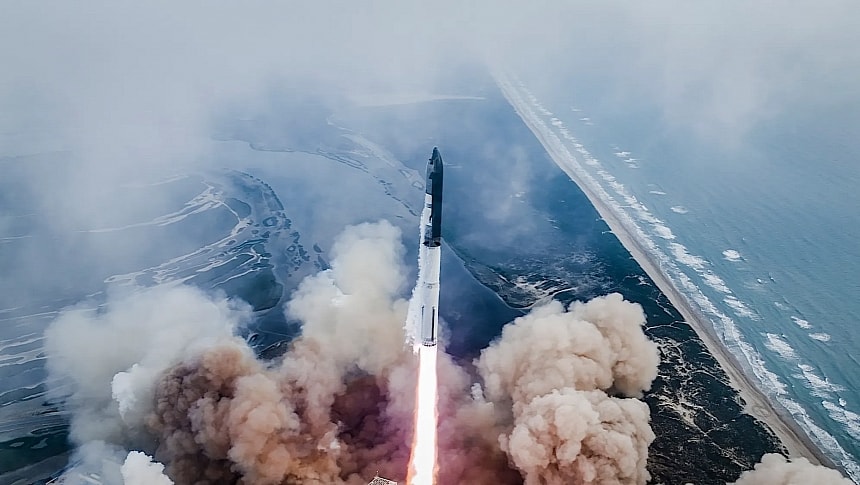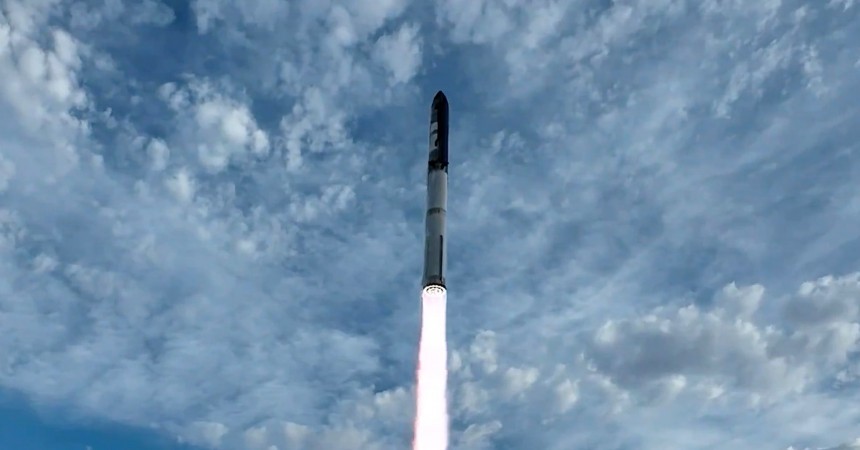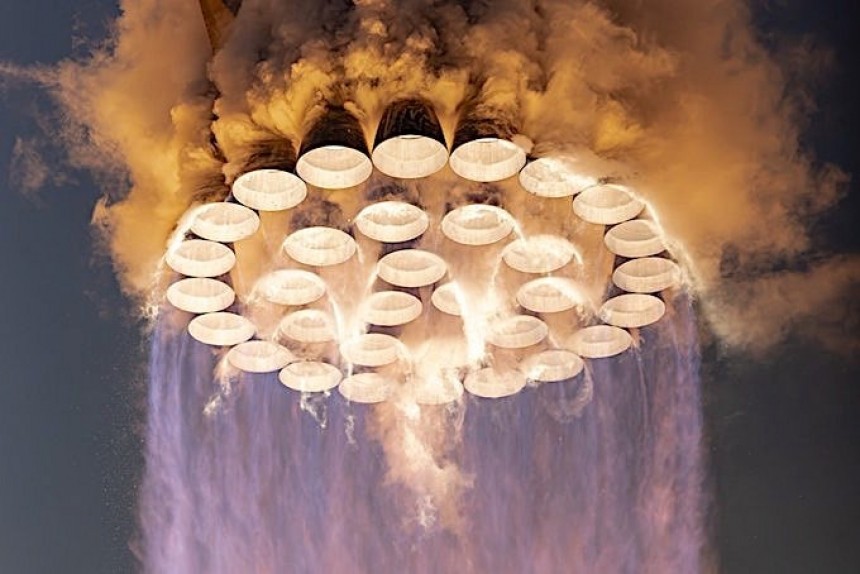They say the third time's a charm, but that doesn't seem to apply to Elon Musk's SpaceX, the company that on Thursday declared a third iteration of its mighty Spaceship a complete loss. Yet it is a loss that, strangely enough, comes with a lot of gains for Space in particular and the space exploration industry in general.
Back in 2023, SpaceX conducted two test flights of the spacecraft that is meant to take humans to the Moon and later on to Mars. The most recent took place in November, with the world's "most powerful launch vehicle ever developed" taking off from the Boca Chica, Texas launch pad and heading to the skies.
The test proceeded as planned until the Starship spacecraft separated from the Super Heavy booster it was attached to. As soon as it ignited its own engines, it caused the Super Heavy to fail and then blow up, eventually taking the ship itself with it as the flight termination system kicked in.
The same location was used for Thursday's test flight, with the Starship assembly (which confusingly comprises the Starship spaceship and the Super Heavy booster, just like before) lifting off at 9:25 a.m. ET.
The main goal of this mission was to see if the rocket could shoot the spacecraft to orbital speeds, meaning fast enough for it to be able to make orbit. In essence, that would mean raking the ship to around 17,500 mph (28,000 kph).
Unlike both previous test flights of the integrated Starship, that mission was accomplished this time, as the set speed was reached, marking an important moment in the development of a space transportation system that may forever change our world. But that's not the only thing the third Starship managed to do, as the list is longer and a tad more impressive.
First up, the duration of the flight. The spacecraft was in the air for close to an hour, marking the longest mission of its kind and also the first time it ran through the first full-duration ascent burn.
Then, it made it further than any other iteration before it (or, should I say, higher), as the spacecraft reached an altitude of 145 miles (234 km). Once there, it didn't actually enter orbit, as that was not one of the goals of the flight.
But that's not all the rocket and ship did on their way up, as SpaceX demonstrated some more of Starship's abilities on its way up.
As most of you know by now, when the Artemis III mission sets off for the Moon, the Starship is poised to play a major role in it, acting as a landing craft (called Human Landing System, or HLS) on the lunar surface for the astronauts.
Starship will not travel with the astronauts, but it will be sent to the Moon beforehand. First, it will be sent to Earth orbit, where it will be refueled with the help of more launches, and from there it will go to Luna, where it will park itself to wait for the Orion and its crew.
It's the fuel transfer tech that SpaceX (kind of) demonstrated during this third flight of the Starship. No other piece of hardware was involved, as fuel was only moved from one tank to another, but it should have been enough to prove that the concept works.
Separately, the spacecraft also opened and closed, for the first time, its payload door, a crucial bit of hardware for upcoming missions.
It's unclear at this point how both these milestones went, as the data still needs to be analyzed, but at first glance, the results seem encouraging.
The space company never had any plans to recover the Spaceship spacecraft, and it expected it to come down hard in the Indian Ocean. It's unclear what happened to it, as during reentry SpaceX lost contact with it because both its connection with the Starlink constellation and the Tracking and Data Relay Satellite System (TDRSS) failed.
As for the Super Heavy booster, that one was supposed to come down in a controlled landing in the ocean. It was lost too because not all of its engines ignited, robbing it of the chance of experiencing a controlled descent.
Despite yet another apparent failure of the Starship program, the third flight was without a doubt the most successful to date, and a clear indication that the space company that has revolutionized the industry is making progress.
NASA in particular seems pretty pleased with the outcome, saying that "the ability to test key systems and processes in-flight scenarios like these integrated tests allows both NASA and SpaceX to gather crucial data needed for the continued development of Starship HLS."
As for what's up next for the SpaceX rocket and spacecraft, a period of data analysis will likely follow, culminating, most likely, with a fourth test flight. The company needs to have the Spaceship ready to fly (and land) by 2026, when the Artemis III mission is scheduled to lift off.
The test proceeded as planned until the Starship spacecraft separated from the Super Heavy booster it was attached to. As soon as it ignited its own engines, it caused the Super Heavy to fail and then blow up, eventually taking the ship itself with it as the flight termination system kicked in.
The same location was used for Thursday's test flight, with the Starship assembly (which confusingly comprises the Starship spaceship and the Super Heavy booster, just like before) lifting off at 9:25 a.m. ET.
The main goal of this mission was to see if the rocket could shoot the spacecraft to orbital speeds, meaning fast enough for it to be able to make orbit. In essence, that would mean raking the ship to around 17,500 mph (28,000 kph).
Unlike both previous test flights of the integrated Starship, that mission was accomplished this time, as the set speed was reached, marking an important moment in the development of a space transportation system that may forever change our world. But that's not the only thing the third Starship managed to do, as the list is longer and a tad more impressive.
First up, the duration of the flight. The spacecraft was in the air for close to an hour, marking the longest mission of its kind and also the first time it ran through the first full-duration ascent burn.
But that's not all the rocket and ship did on their way up, as SpaceX demonstrated some more of Starship's abilities on its way up.
As most of you know by now, when the Artemis III mission sets off for the Moon, the Starship is poised to play a major role in it, acting as a landing craft (called Human Landing System, or HLS) on the lunar surface for the astronauts.
Starship will not travel with the astronauts, but it will be sent to the Moon beforehand. First, it will be sent to Earth orbit, where it will be refueled with the help of more launches, and from there it will go to Luna, where it will park itself to wait for the Orion and its crew.
It's the fuel transfer tech that SpaceX (kind of) demonstrated during this third flight of the Starship. No other piece of hardware was involved, as fuel was only moved from one tank to another, but it should have been enough to prove that the concept works.
Separately, the spacecraft also opened and closed, for the first time, its payload door, a crucial bit of hardware for upcoming missions.
It's unclear at this point how both these milestones went, as the data still needs to be analyzed, but at first glance, the results seem encouraging.
As for the Super Heavy booster, that one was supposed to come down in a controlled landing in the ocean. It was lost too because not all of its engines ignited, robbing it of the chance of experiencing a controlled descent.
Despite yet another apparent failure of the Starship program, the third flight was without a doubt the most successful to date, and a clear indication that the space company that has revolutionized the industry is making progress.
NASA in particular seems pretty pleased with the outcome, saying that "the ability to test key systems and processes in-flight scenarios like these integrated tests allows both NASA and SpaceX to gather crucial data needed for the continued development of Starship HLS."
As for what's up next for the SpaceX rocket and spacecraft, a period of data analysis will likely follow, culminating, most likely, with a fourth test flight. The company needs to have the Spaceship ready to fly (and land) by 2026, when the Artemis III mission is scheduled to lift off.
Watch Starship’s third flight test → https://t.co/bJFjLCiTbK https://t.co/1u46r769Vp
— SpaceX (@SpaceX) March 14, 2024












